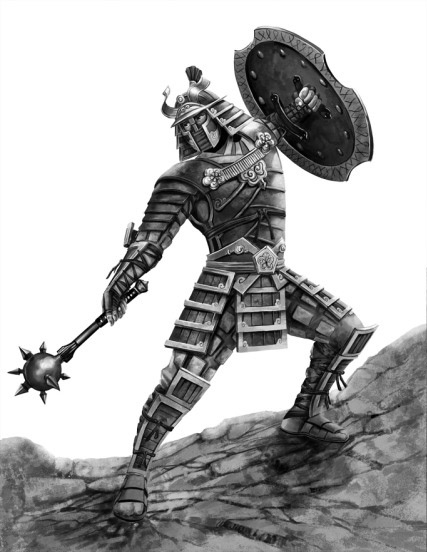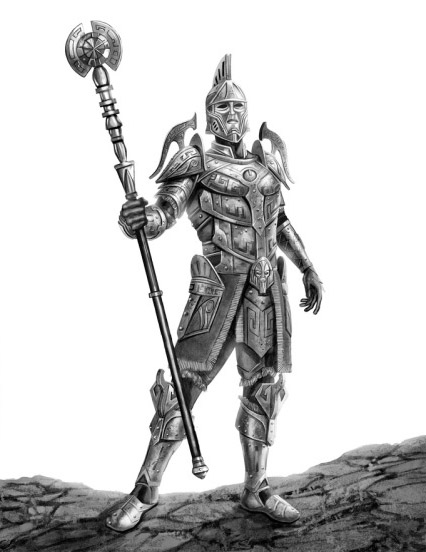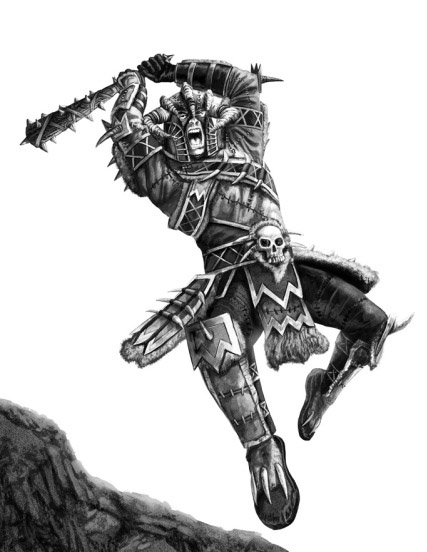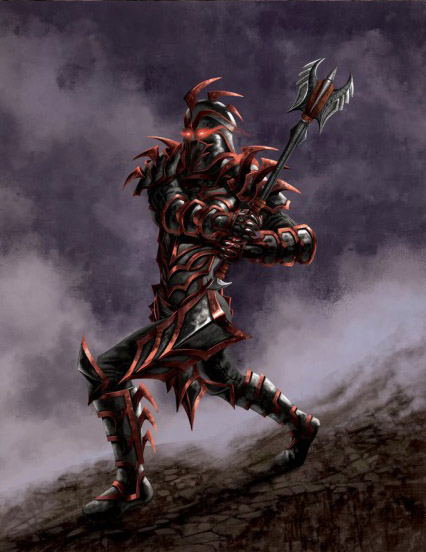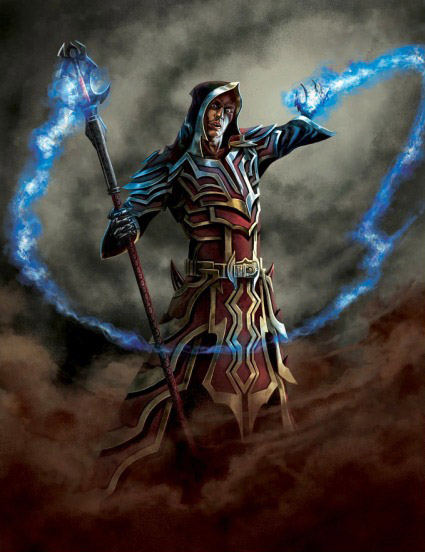Utilisateur:Destroy/bac-à-sable/Regroupement de force/Chapitre 5
Real author : David S. J. Hodgson (Écrivain), Caio Cacau (Artiste) Original media : The Hero's Guides to The Elder Scrolls Online
By Longinus Attius, 2E 581
M UCH AS IN the highly respected guild of western Colovia, all those competent with blade or bow are welcome here, regardless of their standing in society (although those from military bloodlines are often favored). For those that prove themselves in battle, or are ready to fully commit to our cause, the finest blacksmiths this side of Stormhaven have prepared a special set of ceremonial armor and fine weaponry appropriated and improved from a set of parchments of the Imperial explorer Potitus Platorius, and his sketches of the rumored (and armored) inhabitants of Akavir.
Whether you opt for the swirled fabric of our hooded light armor, or the fanciful helm with its odd but practical chin drawstrings and forehead crest work, your armor is both imposing and impressive to those you encounter. A fabric of blue-dyed pauldron plates complements the deep brown plate work and the deep golden chest filigree. Specially stained leather of the same blue hue is finely wrapped around the hilt of each sword, mace, or bow grip. Blades are strong and slightly curved for those who favor the weight of a scimitar, or tapered and straight for the more traditional amongst you. Scroll-like flourishes adorn the quillon or bow shaft. Most weapons have a tone of gold and an outer silver sharpness, aside from the thick bludgeoning spikes of the maces.
T HOUGH MY COLOVIAN blood runs cold when attempting to trust those with an aptitude for magic (as many are seen as traitorous to our path—or worse, in league with the Daedra), there are many across this land that may wish to raise both a sword and a swirling fist of incantation. Casting aside the robes appropriated by many a magician of the Mages Guild in favor of slightly more restrictive armor (metal body pieces constructed with the free flowing of magic in mind), our brethren visiting us from the Mages Guild reveal a finely fluted set of golden plate.
While I favor a more solid and less windswept design when wading into bloody battle, and some feel the feathered shoulder plates and head crests lack a certain savage ferocity, I can appreciate the exceptional gift of skill possessed by the forge masters responsible for these masterpieces of the usage at war, said to be inspired by the armor and armaments of the ancient Elves. A Nord might not appear dignified when clamped into this tightly clasped outfit, but a mage can weave his magic, as well as punish his foe, with a glass weapon that may look delicate but packs a mighty wallop with the strength of steel. Studded runes and sweeping, refined forms show that spellswords allied to this guild have highly prized equipment to rival even our own blades and gauntlets.
M AY YOUR KILLS be quick and many!" So say the Ashlanders, a tribe of Dunmer harking back to the old ways of the Nerevarine cult and the prophet Veloth. While there was an uneasy truce between our Ashlander emissary and Bekleri Llenim, the Dunmeri champion, a separate dwelling, a slice of scuttle, and a tipple of golden wine helped temporarily mend the divide. While Azura's curse allows the Dunmer to take on a grim countenance, the Ashlander warrior adds ritual paint and markings to further emphasize his grayish-blue skin tones and piercing red eyes.
Heavier armor is almost never worn (it seems only crafted to be presented to a high-ranking village chief or elder). Instead, guar leather and chitin plates adorn the more primitive Dunmer, shells carefully heated and cooled until malleable, then pressed and twisted to form breastplate, fauld lames, and even elements of the asset, along with the shoulder plates. Ebony is usually shunned; the Ashlander crafts folk prefer sealed resin, strapped leather wrapping, and rudimentary mace spikes or serrated sword edges. Those wishing the twisted blade of a dagger under their ribs might compare this to the arms of a Reachman. But I would never stoop so low.
T HOUGH THE HISTORY of the Dwemer is hard to pinpoint after the cataclysm at the Battle of Red Mountain in 1E 668, artifacts of these slender, bearded mer of mystery are occasionally gathered by despoilers chancing upon the mechanical undercities of the northern provinces. You may seek out a well-to-do merchant or explore the vast, echoing stone and bronze tombs, where wayward and unrelenting bronze statues clatter to life and display their ornate protection admirably. The armor seen here was duly appropriated and worn by my steward Hardalio Orestillus, who obliged us by attempting resplendence in the armor of this strange people and their mechanical men.
It takes a keen eye and a knowledge of the unique bronze mineral the ancient Dwarves forged into their constructs to differentiate between a fully armored fellow clad in Dwemer artifacts and a clanking, grinding golem hissing and spinning its wrath (although escaping steam is a hint). Armor is of spectacular quality; even under my magnifying glass, imperfections are almost never seen. Pattern work is angular and abstract. Most weapons are purloined from the golden fingers of a steam puppet. A Dwemer mace or axe has a sturdy, subterranean feel, but without the grinding cogs and whistling pistons. While our finest forgers try to copy these scraps of the past, all further knowledge of the true methods of initial.
F ETID CORRUPTIONS OF Orcs, or so the fanciful historical parchments would have you believe, Goblins have run unchecked in marauding tribes throughout the lands. Not feeling the need to communicate except with a series of grunts and loud yells during combat, our prisoner seems to have carried the tattered standard of a warchief, which was duly discarded when our guild members met and slaughtered his confused band of dirt scrabblers. After he was chained in our prison pens, willfully resisting our attempts at befriending, our Khajiiti champion faced him in the pit and was easily victorious.
Astute armory scholars may recognize the spoor-stained breastplate and punctured graves of this repellent specimen, for Goblins have no breadth of craftsmanship or clarity of vision: These are stolen pieces, no doubt scavenged from a backstabbed hunter. Smaller daggers seem to be terribly primitive imitations, formed in forges without the proper bellows and heat, and the results border on the disastrous: rather than piercing flesh, one sword shattered during battle against one of my men. This piteous mass idly waved an axe at us, another purloined piece from a higher race, poorly cared for, rusting, with rotting straps and filth spread across every surface. It is kinder to burn such armaments than offer them for repair.
C AUGHT ALONG THE western edge of Whiterun Hold by our Nord friend Skegglund Stormcloak, this caged blight on the provinces of Skyrim and Wrothgar is an unwashed mongrel brute and known bedfellow of hagravens. Praying to Daedra and Witchmen, scarred by infected tattoo and ritual markings, Cagarach was ready and willing to accept a knot of poisoned briars for a heart, in order to master invincibility in battle. Yet here he sits, spitting at us and wallowing in his filth. The smell from the armor would make a troll's eyes water. But the clan makings and primitive stitching require further inspection.
Aside from the feet, which Reachmen sometimes leave exposed to aid in their movement across scree and down ravine, even the weightiest armor is skinned creature pelts, tanned and pounded into extremely rough hides, then strengthened with boiled resin and, occasionally, hag magic. Bones are sharpened to ensure even a glance from a shoulder plate or fan plate results in a deep slash to the victim, the most hapless of which are pierced to the skull. Helms are twisted bone or pointed antlers. Weaponry is bear, wolf, or found carrion bone, or sharp-edged flint for an axe, woven with leather strips, spittle, and other, less savory, bindings. Black briar thorn arrowheads with raven-feather tails fly from their bows, drawn on strings made of the guts of the recently slain. A mocking grave singer, soon to be put to the sharp end of my sword.
I WAS INSTRUCTED to remain a trifle lackadaisical about my personal hatred of the Daedra, as the recent and open veneration of the Daedra lords in the lands of Cyrodiil by the aristocracy has created quite the rift. But look where this appeasement has gotten us. Now this rift has turned into a yawning chasm, the dead have risen to dance for the worm cult priests, and Molag Bal's talons anchor the now-forlorn countryside. I cannot silence my thoughts. The forces of the Daedra must be slain at all costs.
Be certain to search out the beast that hides behind this armor of red and black, a cruel set of barbed implements to slice and gouge at his or her side. Fear the malice of these ebony axes or swords designed to inflict suffering before death, daubed in crimson ore, a metal cast in otherworldly forges and often augmented in the hilt or pommel with a volcanic gem, always red as blood. There is devilry in this heraldry; mocking and fanged faces peer out from shields and shoulder plates, effigies of false gods or those that lurk beyond our realm. While the worm cultist raises his dead in tarred and tattered robes, hooks of metal sprout from the gorges to the sabaton of a Daedric fighter, always the red of fiendish ferocity. Only the eyes show behind this wall of obscene metal. Only the eyes.
|
